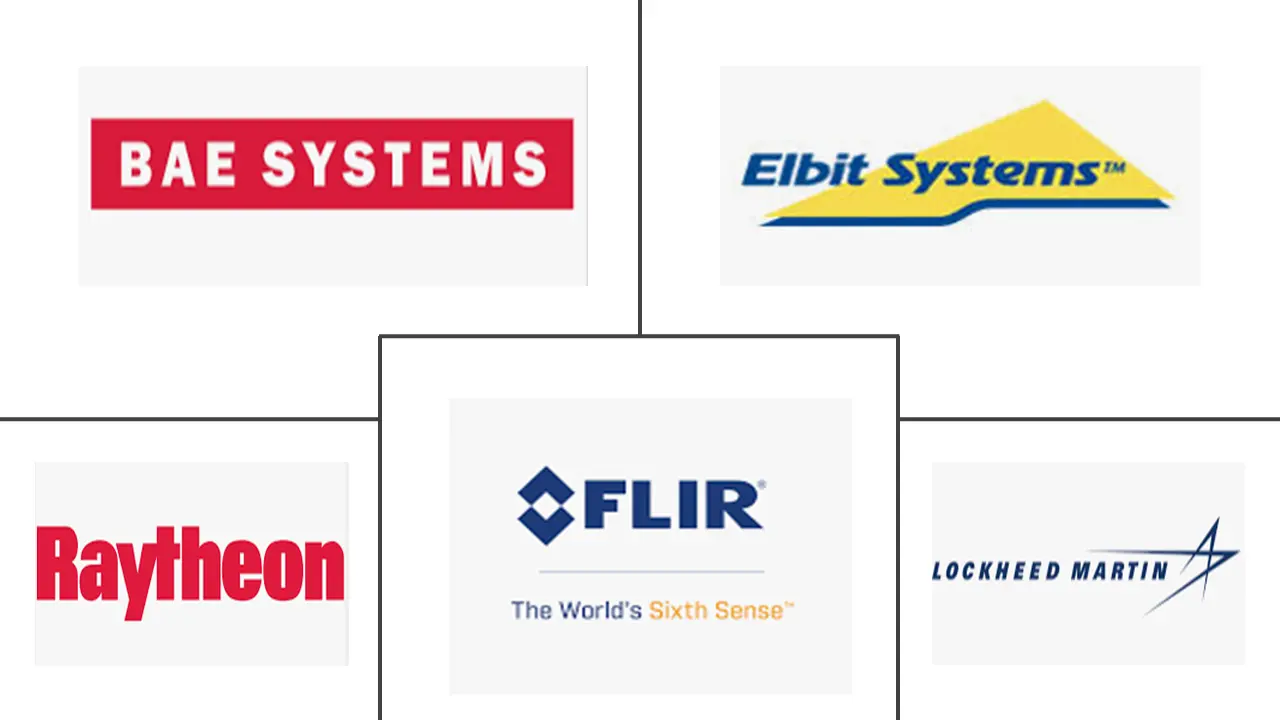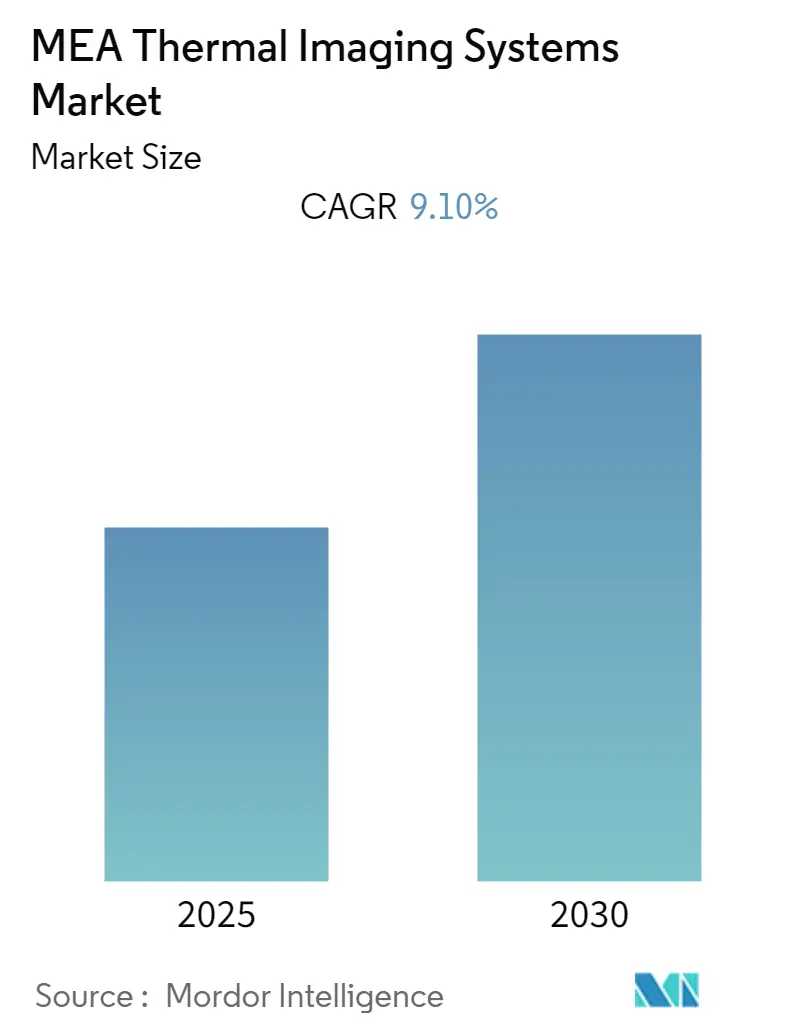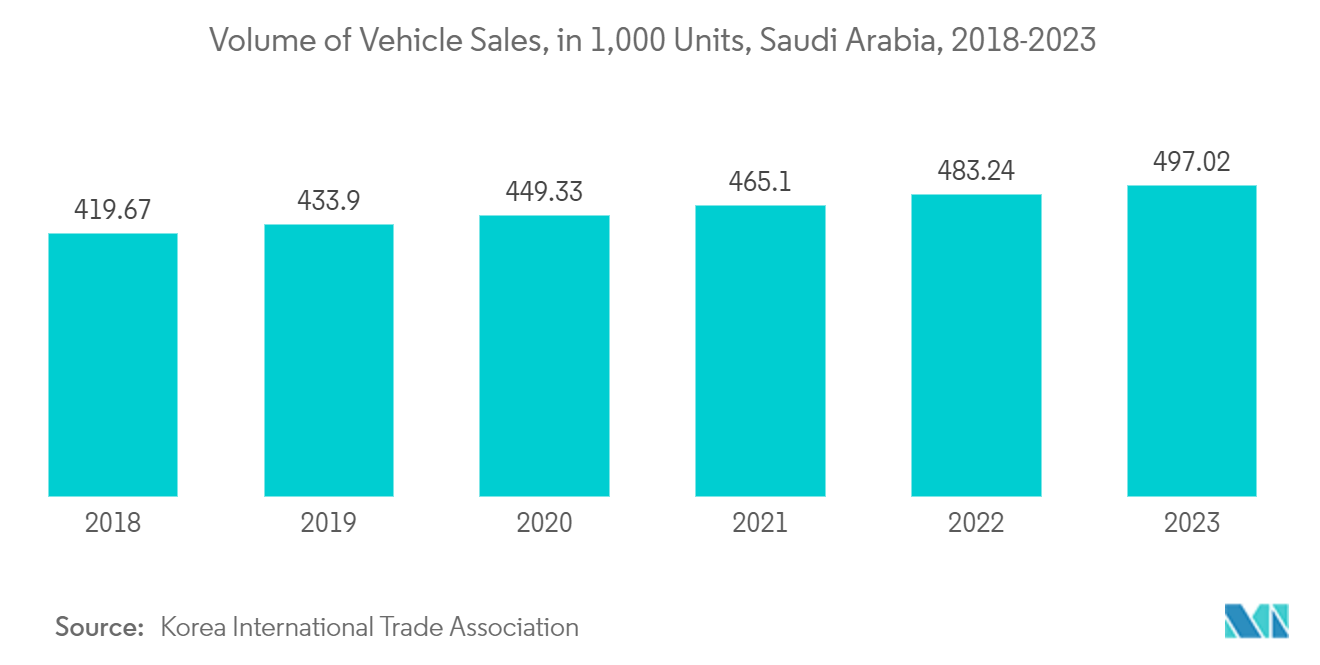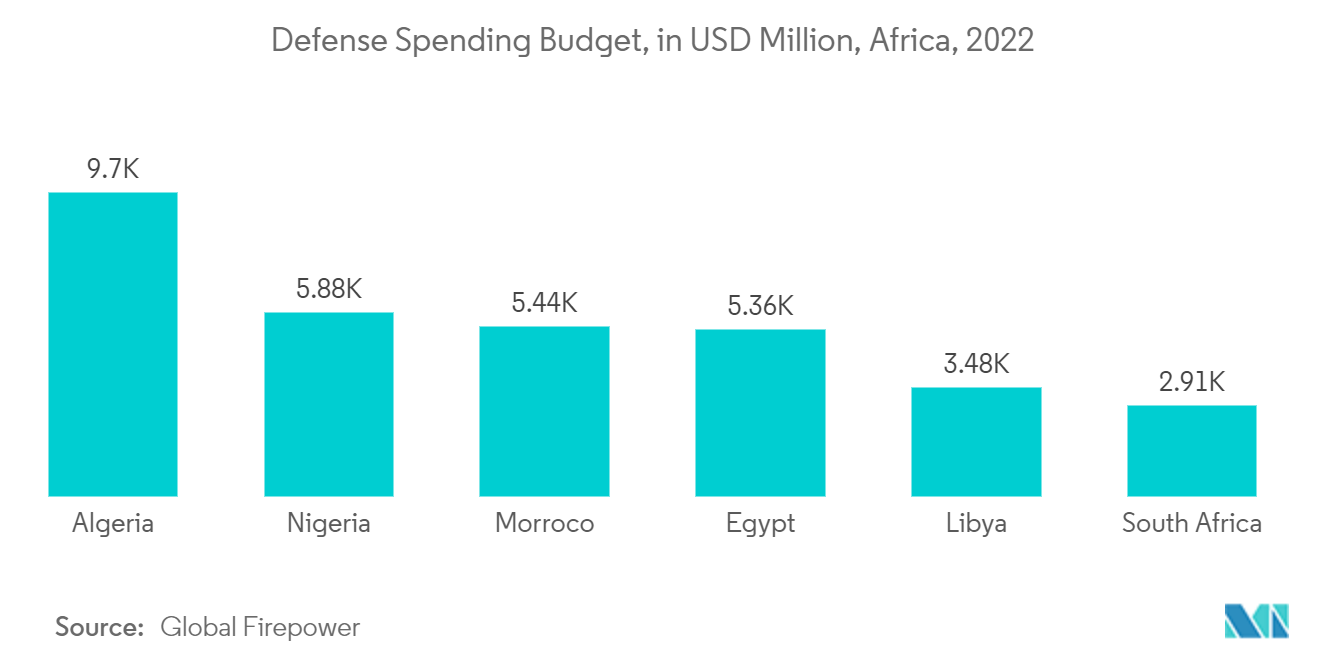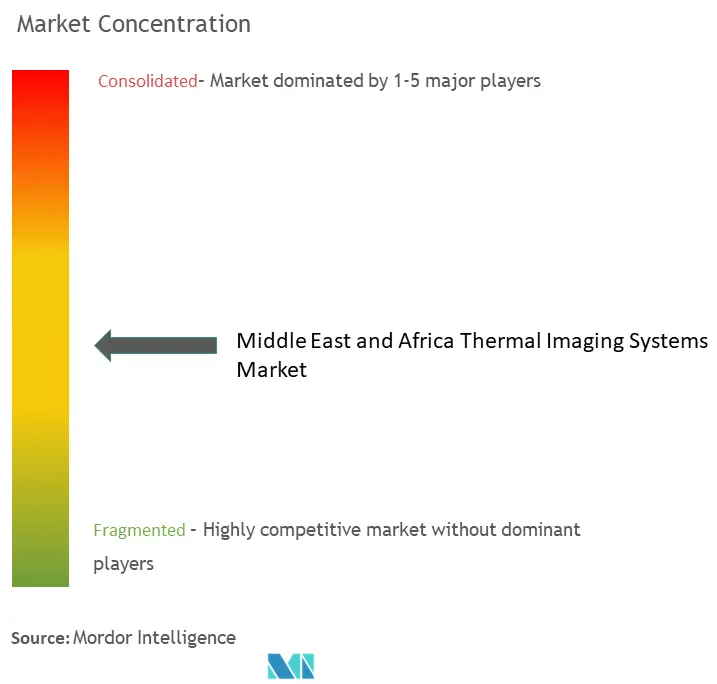Middle East and Africa Thermal Imaging Systems Market Analysis
The MEA Thermal Imaging Systems Market is expected to register a CAGR of 9.1% during the forecast period.
- In the Middle East and Africa, there is a lot of conflict between ISIS, Al-Qaeda, Al-Shabaab, Boko Haram, and other terrorist groups. In both Africa and the Middle East, there is always geopolitical upheaval. The Middle East is a significant buyer of military hardware. Thermal imaging technology aids the military forces in the region in their war against rebels and terrorists in the region's rough terrains. Recently, Qatar's military spent USD 11.6 billion, making it the fifth largest spender in the Middle East.
- Furthermore, the growing applications of thermal cameras, such as rescue operations, crime investigation, road safety, and so on, have boosted the overall market growth. Thermal cameras can also help firefighters locate hotspots and see through smoke, which can help prevent catastrophic accidents. Furthermore, the growing preference for Advanced Driver-Assistance Systems and rising demand for wireless temperature sensors drive the studied market growth.
- For instance, in February this year, UAE-based Teledyne FLIR announced the launch of the FLIR Cx5, a new pocket-portable thermal camera for condition monitoring in hazardous environments. The FLIR Cx5 has a robust ATEX-compliant case, which authorizes users of this camera to monitor electrical or mechanical assets in hot working zones safely.
- According to the new military strategy, the Saudi Arabian armed forces will modernize their military capabilities by acquiring high-tech and effective weapon systems that provide them with military superiority. To protect Saudi Arabia against internal threats such as extremism and terrorism, the Saudi Arabian Defense Doctrine (SDD) outlines several goals to enhance its military structure and capabilities. Further, the government of the Kingdom plans to increase the local military equipment spending to 50% by 2030. Such developments by governments in the region are anticipated to drive the growth of the market during the forecast period.
- Increased demand for IR cameras is driven by factors such as the growing need for surveillance across various industries, the continual reduction of thermal camera costs, and the rapid development of high-speed infrared cameras. Inaccurate measurements and picture color problems associated with cameras, on the other hand, pose a threat to the industry's growth. The military and defense industries, as well as vehicles, rely heavily on infrared cameras.
- COVID-19's breakout and spread have caused a halt in the region's economic development. It has harmed several sectors, including thermal imaging. Companies were preparing and trying to keep their operations running. The primary obstacles that businesses encounter are product manufacturing and distribution. To restrict the spread of the epidemic, some nations worldwide have implemented or extended lockdowns, causing interruptions in the thermal imaging market's supply chain. Furthermore, the market is expected to grow in the forecast period as various industries such as Automotive, Aerospace and Defense, and many others are proliferating in the region.
Middle East and Africa Thermal Imaging Systems Market Trends
Automotive Sector is Expected to Drive the Market Growth
- The automotive industry uses thermal imaging as part of the safety system (E.g., identification of animals or humans on the road and warning the drivers before they encounter these potential hazards). Rear-view visibility systems (backup cameras) are now becoming mandatory on all new light vehicles sold in the United States. With autonomous cars coming into the picture, this technology can facilitate automatic breaking by distinguishing based on object size.
- Furthermore, in January last year, OmniVision, a global developer of semiconductor solutions such as advanced digital imaging, analog, and touch and display technology, announced the latest addition to its ground-breaking Nyxel near-infrared (NIR) technology family at CES. The new OX05B1S is the first 5-megapixel (MP) RGB-IR BSI global shutter sensor for in-cabin monitoring systems in the automotive industry (IMS). It has a 2.2m pixel size and 940 nm NIR sensitivity for the best performance in low light conditions; it has a wide field of view and enough pixels to see both the driver and the occupants.
- According to Korea International Trade Association, The volume of vehicle sales in Saudi Arabia recorded 483.24 thousand units in 2022, and it is forecasted at 497 thousand units for 2023, continuing the upward trend. Further, the country is developing a car manufacturing city as a part of the 2030 Vision reform plan. This move is expected to increase the demand for studied market.
- Moreover, in January 2022, Teledyne FLIR announced the availability of an expanded free thermal dataset for researchers and developers working on Advanced Driver Assistance Systems (ADAS) and self-driving vehicles. The expanded starter dataset nearly doubles the original, industry-first free dataset and includes over 26,000 annotated images from the United States, England, and France in day and nighttime conditions. It also triples the number of categories, with people, bikes, cars, motorcycles, buses, trains, trucks, traffic lights, fire hydrants, street signs, dogs, skateboards, stroller scooters, and other vehicle labels now included. The expanded free starter thermal imaging dataset enables the automotive and academic communities to evaluate the performance of vehicle safety algorithms quickly.
- Furthermore, the automobile industry is now gaining traction with high-tech autonomous cars, also known as Advanced Driver-Assistance Systems (ADAS) or driverless vehicles. Multiple sensors, including thermal cameras, Radio Detection and Ranging (RADAR), Light Detection and Ranging (LIDAR) sensor, and proximity sensor, substitute drivers in these cars to enable automated driving, navigation, and better situational awareness.
- Such developments in the automotive industry in the region may further create significant growth in the studied market.
Aerospace and Defense Holds Significant Market Share
- Thermal imaging systems allow ground troops to detect differences in temperature between inanimate objects and enemy forces. These devices collect the infrared radiation in the camera's field of vision and use that information to create an image. In addition, the military thermal imager is one of the essential optical devices for hunting or modern combat. Fog or dust, day or night, the thermal imaging device delivers flexibility, versatility, and tactical superiority at any time of the year and in any weather.
- Governments all across the region are investing in next-generation technology by giving better and more accurate information to military troops. The use of IR thermography equipment in the military industry has grown, influencing the rise of infrared cameras, particularly short-wavelength IR cameras.
- For instance, in April last year, Teledyne FLIR, part of Teledyne Technologies Inc., announced the release of its high-performance Hadron 640R combined radiometric thermal and visible dual camera module. The Hadron 640R design is optimized to integrate uncrewed aircraft systems, unmanned ground vehicles, robotic platforms, and emerging AI-ready applications where battery life and run-time are mission-critical.
- There is a significant trend of increasing crime and violence in the region. As a result of this element, the budgets of the homeland security forces have increased to purchase advanced protection systems and devices. With an expanding number of non-lethal and deadly weapons, modern combat has grown increasingly asymmetric. According to Global Firepower, as of the last year, Algeria had the highest defense spending budget in Africa, around USD 10 billion. Nigeria and Morocco followed, with a budget of roughly USD 5.9 billion and USD 5.4 billion.
- Furthermore, the governor of GAMI announced that the Saudi Arabia Government (SAG) is looking forward to investing USD 20 billion in its military industry for the next decade. Out of the investment, half of this amount shall be dedicated to the general defense industry, and the remaining half will be invested in R&D. Furthermore, the country plans to increase its military R&D spending from 0.2% to approx. Around 4% of its armament's expenditure by late 2030. Such developments by governments in the region are anticipated to drive the growth of the market during the forecast period.
Middle East and Africa Thermal Imaging Systems Industry Overview
The Middle East and Africa Thermal Imaging Systems market is partially fragmented and consists of several major players. Some major players like Flir, Bae Systems, Elbit Systems Ltd., Raytheon Co., and L-3 Communications are already present in the thermal imaging systems market. However, many companies are increasing their market presence with innovative solutions by securing new contracts and tapping new markets.
- June 2022 - Teledyne FLIR, a division of Teledyne Technologies Incorporated, has added an E52 camera to its Exx thermal Imaging device line, which already includes the E96, E86, E76, and E54 models. The new E52 camera has a professional thermal resolution to ensure clear images and on-camera routing to improve field survey efficiency.
- January 2022- Xenics has launched the Ceres T 1280, a new high-performance, high-resolution thermographic long-wave infrared (LWIR) camera. Xenics is expanding its high-performance thermographic camera line with the Ceres T 1280.
Middle East and Africa Thermal Imaging Systems Market Leaders
-
Flir Systems, Inc.
-
BAE Systems plc
-
Elbit Systems Ltd.
-
Raytheon Company
-
Lockheed Martin Corporation
- *Disclaimer: Major Players sorted in no particular order
Middle East and Africa Thermal Imaging Systems Market News
- May 2022- Owl Autonomous Imaging announced the Evaluation Kit for its Thermal Ranger ADAS & Autonomous Navigation Development Platform at CES,2023. This hardware and software kit enables Tier 1 and OEM automotive companies to quickly evaluate Owl AI's Thermal Ranger imaging solution for use in their Pedestrian Automatic Emergency Braking and other ADAS applications supporting L2, L2+, and L3/L4 requirements.
- February 2023- The Ministry of Health and Prevention (MoHAP) has launched a 3D digital metaverse assessment service and innovative thermal imaging technology for health professionals. MoHAP unveiled a new medical thermal imaging technology, allowing healthcare providers to use cutting-edge innovations more effectively.
Middle East and Africa Thermal Imaging Systems Industry Segmentation
Thermal Imaging Technology enables users to detect objects or individuals in complete darkness and difficult and distinct conditions. Unlike the other methods, thermal imaging works in environments without ambient light. Like near-infrared illumination, thermal imaging can penetrate obscurants like smoke, fog, and haze. The studied market is segmented by various solutions such as Hardware, Software, and Services among Fixed and Handheld Thermal Cameras product types in multiple applications such as Security and Surveillance, Monitoring and Inspection, Detection, and Measurement. Further, the market is also segmented by different end-users, such as Aerospace and Defense, Automotive, Healthcare and Life Sciences, Oil and Gas, and Food and Beverages among multiple countries. The market sizes and forecasts are provided in terms of value (USD million) for all the above segments. The impact of Covid-19 on the market and impacted segments are also covered under the scope of the study. Further, the disruption of the factors affecting the market's expansion in the near future has been covered in the study regarding drivers and restraints. The market sizes and forecasts are provided in terms of value (USD million) for all the above segments.
| By Solutions | Hardware |
| Software | |
| Services | |
| By Product Type | Fixed Thermal Cameras |
| Handheld Thermal Cameras | |
| By Application | Security and Surveillance |
| Monitoring and Inspection | |
| Detection and Measurement | |
| By End-user | Aerospace and Defense |
| Automotive | |
| Healthcare and Life Sciences | |
| Oil and Gas | |
| Food and Beverages | |
| Others | |
| By Country | Saudi Arabia |
| United Arab Emirates | |
| Rest of Middle East and Africa |
Middle East and Africa Thermal Imaging Systems Market Research FAQs
What is the current MEA Thermal Imaging Systems Market size?
The MEA Thermal Imaging Systems Market is projected to register a CAGR of 9.1% during the forecast period (2025-2030)
Who are the key players in MEA Thermal Imaging Systems Market?
Flir Systems, Inc., BAE Systems plc, Elbit Systems Ltd., Raytheon Company and Lockheed Martin Corporation are the major companies operating in the MEA Thermal Imaging Systems Market.
What years does this MEA Thermal Imaging Systems Market cover?
The report covers the MEA Thermal Imaging Systems Market historical market size for years: 2019, 2020, 2021, 2022, 2023 and 2024. The report also forecasts the MEA Thermal Imaging Systems Market size for years: 2025, 2026, 2027, 2028, 2029 and 2030.
Our Best Selling Reports
Middle East and Africa Thermal Imaging Industry Report
Statistics for the 2025 MEA Thermal Imaging Systems market share, size and revenue growth rate, created by Mordor Intelligence™ Industry Reports. MEA Thermal Imaging Systems analysis includes a market forecast outlook for 2025 to 2030 and historical overview. Get a sample of this industry analysis as a free report PDF download.

